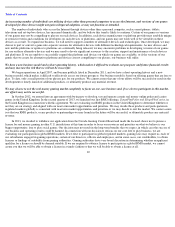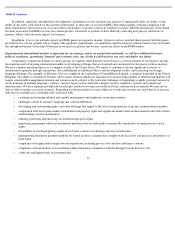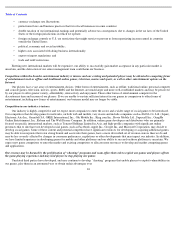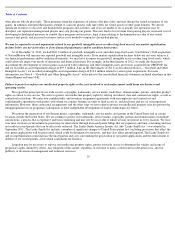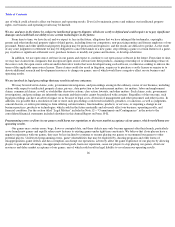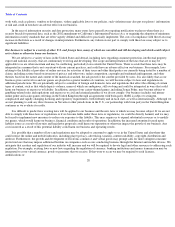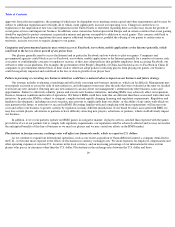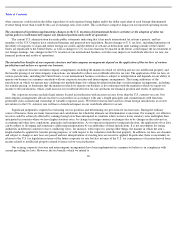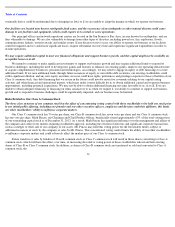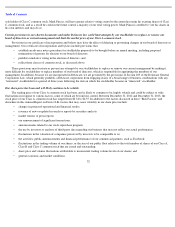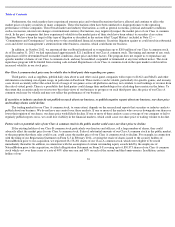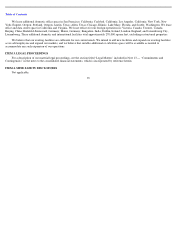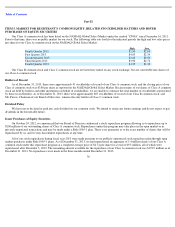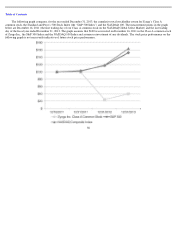Zynga 2013 Annual Report Download - page 35
Download and view the complete annual report
Please find page 35 of the 2013 Zynga annual report below. You can navigate through the pages in the report by either clicking on the pages listed below, or by using the keyword search tool below to find specific information within the annual report.
Table of Contents
eventually derive could be undermined due to changing tax laws or if we are unable to adapt the manner in which we operate our business.
Our facilities are located near known earthquake fault zones, and the occurrence of an earthquake or other natural disaster could cause
damage to our facilities and equipment, which could require us to curtail or cease operations.
Our principal offices and network operations centers are located in the San Francisco Bay Area, an area known for earthquakes, and are
thus vulnerable to damage. We are also vulnerable to damage from other types of disasters, including power loss, fire, explosions, floods,
communications failures, terrorist attacks and similar events. If any disaster were to occur, our ability to operate our business at our facilities
could be impaired and we could incur significant losses, require substantial recovery time and experience significant expenditures in order to
resume operations.
We may require additional capital to meet our financial obligations and support business growth, and this capital might not be available on
acceptable terms or at all.
We intend to continue to make significant investments to support our business growth and may require additional funds to respond to
business challenges, including the need to develop new games and features or enhance our existing games, improve our operating infrastructure
or acquire complementary businesses, personnel and technologies. Accordingly, we may need to engage in equity or debt financings to secure
additional funds. If we raise additional funds through future issuances of equity or convertible debt securities, our existing stockholders could
suffer significant dilution, and any new equity securities we issue could have rights, preferences and privileges superior to those of holders of our
Class A common stock. Any debt financing that we secure in the future could involve restrictive covenants relating to our capital raising
activities and other financial and operational matters, which may make it more difficult for us to obtain additional capital and to pursue business
opportunities, including potential acquisitions. We may not be able to obtain additional financing on terms favorable to us, if at all. If we are
unable to obtain adequate financing or financing on terms satisfactory to us when we require it, our ability to continue to support our business
growth and to respond to business challenges could be significantly impaired, and our business may be harmed.
Risks Related to Our Class A Common Stock
The three class structure of our common stock has the effect of concentrating voting control with those stockholders who held our stock prior
to our initial public offering, including our founder and our other executive officers, employees and directors and their affiliates; this limits
our other stockholders’ ability to influence corporate matters.
Our Class C common stock has 70 votes per share, our Class B common stock has seven votes per share and our Class A common stock
has one vote per share. Mark Pincus, our Chairman and Chief Product Officer, beneficially owned approximately 63% of the total voting power
of our outstanding capital stock as of December 31, 2013. As a result, Mark Pincus has significant influence over the management and affairs of
the company and control over matters requiring stockholder approval, including the election of directors and significant corporate transactions,
such as a merger or other sale of our company or our assets. Mr. Pincus may hold this voting power for the foreseeable future, subject to
additional issuances of stock by the company or sales by Mr. Pincus. This concentrated voting control limits the ability of our other stockholders
to influence corporate matters and could adversely affect the market price of our Class A common stock.
Future transfers or sales by holders of Class B common stock or Class C common stock will result in those shares converting to Class A
common stock, which will have the effect, over time, of increasing the relative voting power of those stockholders who retain their existing
shares of Class B or Class C common stock. In addition, as shares of Class B common stock are transferred or sold and converted to Class A
common stock, the
31



